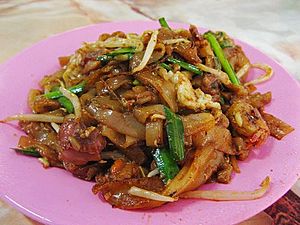Char kway teow facts for kids
 |
|
| Type | Shahe fen |
|---|---|
| Place of origin | Malaysia and Singapore |
| Region or state | Southeast Asia |
| Associated national cuisine | Malaysia and Singapore |
| Main ingredients | Shahe fen, light and dark soy sauce, chilli, belachan, whole prawns, deshelled blood cockles, bean sprouts, Chinese chives, Chinese sausage |
| Char kway teow | |||||||||||||||||||
|---|---|---|---|---|---|---|---|---|---|---|---|---|---|---|---|---|---|---|---|
| Traditional Chinese | 炒粿條 | ||||||||||||||||||
| Simplified Chinese | 炒粿条 | ||||||||||||||||||
| Literal meaning | stir-fry ricecake strips (i.e. stir-fried ricecake strips) | ||||||||||||||||||
|
|||||||||||||||||||
| Alternative name in Cantonese-speaking regions |
|||||||||||||||||||
| Traditional Chinese | 炒貴刁 | ||||||||||||||||||
| Simplified Chinese | 炒贵刁 | ||||||||||||||||||
| Literal meaning | transcription from the original name pronunciation in Hokkien (Min Nan) | ||||||||||||||||||
|
|||||||||||||||||||
Char kway teow (Chinese: 炒粿條; Pe̍h-ōe-jī: chhá-kóe-tiâu) is a super yummy stir-fried noodle dish. It comes from Maritime Southeast Asia and has roots in southern China.
The name "Char kway teow" tells you what it is! In the Hokkien and Teochew languages, "Char" means "stir-fried." "Kway teow" refers to the flat rice noodles used in the dish.
This tasty meal is made with flat rice noodles, usually about 1 cm wide. In northern Malaysia, they might be thinner, around 0.5 cm wide. The noodles are cooked quickly over very high heat.
What makes it so good? It's stir-fried with garlic, light and dark soy sauce, and chilli paste. Then, delicious ingredients like whole prawns, shelled blood cockles, chopped Chinese chives, slices of Chinese sausage, and bean sprouts are added. Sometimes, you'll also find fishcake and belachan (a type of shrimp paste).
This dish was first created for Chinese workers living in Southeast Asia. It became super popular in countries like Malaysia and Singapore from the late 1900s onwards. Traditionally, it was cooked with pork fat, which gave it a lot of energy. This made it a great, cheap meal for people who worked hard.
Contents
What's in a Name? The Story of Char Kway Teow
This dish was often sold by people like fishermen, farmers, and those who gathered cockles. They would sell char kway teow in the evenings to earn extra money. It was a cheap and filling meal, giving them lots of energy and nutrients.
The name "char kway teow" comes from the Chinese characters 炒粿條. It's a Hokkien word (chhá-kóe-tiâu). The dish might have started in a place called Chaozhou in China. It is often linked to the Teochew people. The word kóe-tiâu means "ricecake strips," which are the flat rice noodles.
You might see the name spelled in many ways, like "char kueh teow" or "char koay teow." There isn't just one correct way!
In Malay, the dish is sometimes called kwetiau goreng or kuetiau goreng. This means the same thing: "stir-fried flat rice noodles." In 2021, Malaysia's language authority, Dewan Bahasa and Pustaka (DBP), said that kuetiau is the correct spelling for flat rice noodles in Malaysian Malay.
When char kway teow became popular in areas where people speak Cantonese, its name changed a bit. It became "炒貴刁" (cháau gwai dīu). The words "貴刁" don't have a special meaning, but they sound similar to "粿條" (kway teow) in the Southern Min language.
Different Ways to Enjoy Char Kway Teow
You can find many different versions of char kway teow!
Gourmet and Regional Styles
In big Malaysian cities like Ipoh and Penang, you might find "gourmet" versions. These can have more seafood, like crab meat, or even duck eggs! In Penang, char kway teow is often served on a piece of banana leaf. This is done to make the dish smell even more amazing.
In Singapore, char kway teow is a very popular and cheap dish. People often eat it for breakfast. Most street food stalls include blood cockles and prawns. Some fancier versions might have cuttlefish, squid, or even lobster meat! Singaporean char kway teow often mixes yellow wheat noodles with the flat rice noodles. Some cooks even make healthier versions with more vegetables and less oil.
Muslim-Friendly and Hong Kong Styles
Muslim cooks in Malaysia and Singapore make char kway teow without pork or lard. They might use beef or chicken instead. Some Malay cooks really focus on using kerang (the Malay word for cockles) as a main ingredient. They might also make it with or without gravy.
Many Southeast Asian restaurants in Hong Kong offer char kway teow. However, the char kway teow you find in Chinese restaurants that serve Hong Kong-style Cantonese cuisine is quite different. This version is stir-fried Chinese flat rice noodles with prawns, char siu (barbecued pork), onions, and bean sprouts. It's seasoned with curry powder, which makes it bright yellow! Sometimes, this dish is called Fried "Good Dale", which is a funny way of saying "炒貴刁."
Images for kids
See also
 In Spanish: Char kway teow para niños
In Spanish: Char kway teow para niños




